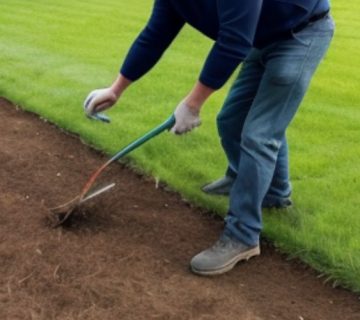Construction and DIY projects are exciting and rewarding endeavours that can enhance. The beauty and functionality of your h1ome. However, they can also generate a significant amount of waste. Which can pose environmental and health hazards if not managed responsibly.
Clear The Lot offers a comprehensive range of services including house clearance, garden clearance, office clearance, fencing, garage conversions, interior decorating, property refurbishment, and scaffolding services in London and Surrey. Visit Clearthelot.com for top-notch cleaning services in these areas.

In this article, we will discuss the various types of construction and DIY waste. The impact of improper waste disposal, and the best practices for managing it responsibly and sustainably.
Types of Construction and DIY Waste
Construction and DIY waste can be broadly classified into the following categories:
Building materials: This includes lumber, bricks, concrete, asphalt, drywall, roofing materials, insulation, and flooring materials.
Hazardous materials: This includes paint, adhesives, solvents, batteries, fluorescent light bulbs, and other chemicals that can pose a risk to human health and the environment.
Electrical and electronic equipment: This includes appliances, computers, televisions, and other electronic devices that contain hazardous materials such as lead, mercury, and cadmium.
Green waste: This includes organic waste such as tree branches, leaves, grass, and other yard debris.
General waste: This includes non-hazardous waste such as packaging materials, food waste, and other miscellaneous items generated during the construction or DIY project.
Clear The Lot offers a comprehensive range of services including house clearance, garden clearance, office clearance, fencing, garage conversions, interior decorating, property refurbishment, and scaffolding services in London and Surrey. Visit Clearthelot.com for top-notch cleaning services in these areas.
House Clearance: Impact of Improper Waste Disposal
Improper disposal of construction and DIY waste can have serious consequences for the environment and public health. Here are some of the negative impacts of improper waste disposal:
Pollution: Hazardous materials can leach into the soil and groundwater, contaminating the environment and posing a risk to public health.
Air pollution: Burning waste releases harmful gases and particulate matter into the air, which can cause respiratory problems and other health issues.
Habitat destruction: Improper disposal of green waste can disrupt ecosystems and harm wildlife.
Legal and financial consequences: Improper waste disposal can lead to fines, penalties, and legal action. which can be costly and time-consuming.

Best Practices for Managing Construction and DIY Waste
To manage construction and DIY waste responsibly and sustainably, it’s important to follow these best practices:
Plan: Before starting your construction or DIY project, consider how you will manage the waste generated during the process. This will help you avoid last-minute scrambling and ensure that you have the necessary resources and tools to dispose of the waste properly.
Separate and sort: Sort the waste into different categories (building materials, hazardous waste, green waste, etc.) and separate them accordingly. This will make it easier to dispose of each type of waste appropriately.
Recycle and reuse: Whenever possible, recycle or reuse the waste materials. Many building materials, such as lumber and concrete, can be recycled or repurposed for future projects. Additionally, many hazardous materials can be recycled or disposed of in an environmentally friendly manner.
Hire a professional House Clearance management company
If you have a large amount of waste to dispose of, consider hiring a professional waste management company. These companies have the expertise and equipment to handle all types of waste and dispose of them responsibly and sustainably.
Dispose of hazardous waste properly: Hazardous waste should never be disposed of in the trash or dumped down the drain. Instead, it should be taken to a hazardous waste collection facility or an authorized disposal site.
Construction and DIY waste can be a challenge to manage. But it’s important to prioritize responsible waste disposal to protect the environment and public health. By understanding the different types of waste generated during these projects and the best practices for disposing of them. You can minimize the negative impact and ensure a safe and healthy environment for yourself and future generations.

In addition to following these best practices. There are several other steps you can take to further reduce waste during construction and DIY projects. For example, you can choose eco-friendly building materials and products, such as recycled content and low-VOC (volatile organic compounds) materials. You can also plan your project to minimize waste generation by cutting materials to the appropriate size and using only what you need.
Furthermore, you can reduce your reliance on single-use materials and products, such as disposable gloves and dust masks, by investing in reusable alternatives. This not only reduces waste but also saves money in the long run. When it comes to disposing of construction and DIY waste.
House clearance London: Local Regulations and Guidelines
It’s important to be mindful of local regulations and guidelines. Many localities have specific requirements for the disposal of certain types of waste, such as hazardous materials or bulky items. It’s important to research these requirements before you begin your project to ensure that you’re able to dispose of waste properly.
In some cases, it may be necessary to hire a professional waste disposal company to handle certain types of waste. For example, hazardous materials like asbestos, lead-based paint, and certain chemicals require special handling and disposal procedures. It’s important to find a reputable company that is experienced in handling these materials and follows all necessary regulations.
Another option for responsible waste disposal is to recycle or donate materials whenever possible. Many construction materials, such as wood, metal, and concrete, can be recycled into new products or reused in future projects. You can also donate materials in good condition to local organizations or charities that can make use of them.
Finally, it’s important to properly dispose of any waste that cannot be recycled or donated. This may include items like drywall, insulation, and other construction debris. Be sure to separate any hazardous materials, such as chemicals or batteries, from the rest of the waste and dispose of them separately.
House Clearance Cost: Conclusion
In conclusion, construction and DIY waste can be a challenge to manage. But it’s important to prioritize responsible waste disposal to protect the environment and public health. By understanding the different types of waste generated during these projects, following best practices for disposal, and taking additional steps to reduce waste generation.

The process is simple if you’re interested in getting garden clearance services from Clear The Lot. You can contact them via 0773 467 8923 or info@www.clearthelot.com to request a quote and schedule an appointment. Their team will visit your property to assess the job and provide a competitive price based on the volume and weight of the waste to be cleared.
We can create a healthier, more sustainable world for ourselves and future generations. In conclusion, construction and DIY projects can be a great way to enhance your home and express your creativity, but they can also generate a significant amount of waste. By following the best practices for managing construction and DIY waste, and taking additional steps to reduce waste generation.
You can enjoy the benefits of these projects while minimizing the negative impact on the environment and public health. Remember, responsible waste disposal is everyone’s responsibility, and by working together, we can create a healthier, more sustainable world for ourselves and future generations.
Construction and DIY projects can generate a significant amount of waste. But by following the best practices outlined in this article. you can manage it responsibly and sustainably. By planning, separating and sorting the waste, recycling and reusing materials, and disposing of hazardous waste properly.




